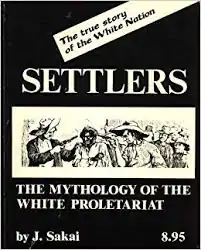Settlers: The Mythology of the White Proletariat
Settlers: The Mythology of the White Proletariat is a 1983 book by American theorist and activist J. Sakai that looks at the history of the United States of America (referred to as Amerika throughout the book) from an anti-imperialist and non-white perspective. The book has been influential among Maoists and Third-Worldists, in particular Maoist–Third Worldists.[1]
 | |
| Author | J. Sakai |
|---|---|
| Country | United States |
| Language | English |
| Subject | Imperialism, Maoism–Third Worldism, Racism, White supremacy |
Publication date | 1983 |
| ISBN | 9781629630762 |
| OCLC | 886112359 |
| 320 | |
| LC Class | E184 .A1 .S253 |
Summary
Settlers argues that the class system in the United States is built upon the genocide of Native Americans and the enslavement of Africans and that the white working class in the United States constitutes a privileged labor aristocracy that lacks proletarian consciousness. Arguing that the white working class possesses a petit-bourgeois and reformist consciousness, Sakai posits that the colonized peoples of the United States constitutes the proletariat.[1]
Publication history
Settlers was originally published under the title Mythology of the White Proletariat: A Short Course in Understanding Babylon. The fourth edition was issued in 2014 by Kersplebedeb Publishing under the title Settlers: The Mythology of the White Proletariat from Mayflower to Modern.
Reception
In his book Continuity and Rupture, J. Moufawad-Paul cited Settlers as a "subterranean movement text" that is an example of a revival of Maoist thought in the late 20th century at a time that Marxism-Leninism was waning.[2]
Settlers has influenced the political thought of David Gilbert, a Weather Underground militant, and included commentary on the work in the 2017 reissue of Gilbert's Looking at the White Working Class Historically.[3]
Sebastian Lamb, writing for Kersplebedeb, criticized the book, saying that "[Settlers] rejects the struggles of the really-existing multiracial working class in the US. In writing off white workers as a reactionary mass, it absolves white radicals of our very difficult responsibility to mobilize white workers against racism in multiracial struggles and in support of the autonomous movements of people of colour."[4]
See also
References
- "Race and class in the United States: J. Sakai and the politics of revolution". Links International Journal of Socialist Renewal. Retrieved 2020-01-20.
- Rastgar, Hamayon (21 December 2016). "Continuity and Rupture: Philosophy in the Maoist Terrain". Marx & Philosophy Review of Books. Retrieved 2020-01-20.
- "Thinking Clearly about the White Working Class". Monthly Review. Retrieved 2020-01-20.
- "J. Sakai's Settlers and Anti-Racist Working-Class Politics, by Sebastian Lamb, New Socialist". Kersplebedeb. 2010-01-25. Retrieved 2021-02-02.